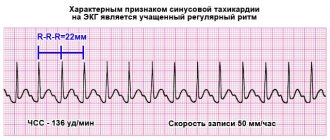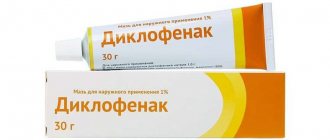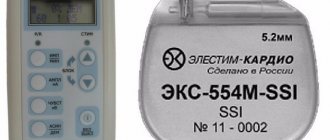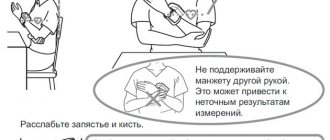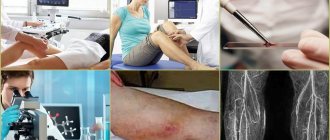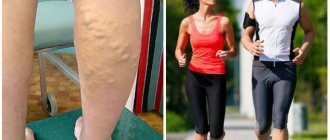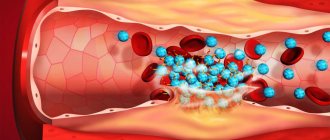Radiofrequency ablation (RFA) has been practiced in Western countries for more than 10 years as a method of rapid and reliable treatment of veins affected by varicose veins. Initially, RFA was used in cardiac surgery to treat arrhythmias. Surgery using radio frequency is the most effective method for treating varicose veins, which has great advantages over other methods. Radiofrequency ablation (RFA) of the veins of the lower extremities in Moscow appeared relatively recently. However, 10 years of practice have shown that this is the most painless and safe endovenous method of treating varicose veins, which gives an amazing effect.
Radiofrequency ablation (RFA Venefit™) - what is it?
Radiofrequency ablation is an intravascular thermal effect on the walls of veins with radiofrequency radiation to close the lumen of a damaged vessel.
Simply put, radiofrequency ablation (RFA) is a kind of “sealing” of a vessel, turning it off from the general blood flow. Otherwise, the RFA method is called Covidien radiofrequency obliteration or previously called VNUS Closure.
The essence of the method itself is to insert a radiofrequency catheter into a varicose vein and step-by-step heat treatment of the area affected by varicose veins.
Radiofrequency ablation (RFA) - Wikipedia says that...
The RFA method is more appropriate for the treatment of both small and large veins with a lumen diameter of more than 15 mm. If the lumen of the vein is no more than 3 mm, then it is more advisable to use laser vein obliteration, since the light guide is slightly thinner than a radiofrequency catheter.
Radiofrequency ablation (RFA) of veins is technically difficult to perform even on vessels that have a pronounced bend or a special structure. However, in the small and great saphenous veins, which are most often subjected to radiofrequency “welding,” serious bends that impede the passage of the catheter are extremely rare.
Indications and contraindications
The procedure is recommended for the following medical indications:
- varicose veins (starting from the second degree, there is a lack of oxygen and nutrients);
- post-thrombotic diseases (a case when it is impossible to save the vessels and their removal is required);
- venous insufficiency (in its chronic form, it is used in conjunction with drug treatment).
Those for whom compression is contraindicated should not resort to this method, namely:
- pregnant women, as well as women during breastfeeding;
- people who experience atherosclerotic changes in the walls of blood vessels;
- thrombosis of deep and superficial veins;
- patients with severe skin diseases (purulent-inflammatory processes of a viral or infectious nature);
- patients suffering from overweight and obesity.
This prohibition is associated with the inadmissibility of compression of body tissues.
Advantages of radiofrequency ablation (RFA) over classical operations
RFA has a number of advantages compared to other radical methods of treating varicose veins:
- highest efficiency achieved through precise impact
- possibility of outpatient treatment
- painlessness of the method and easy tolerability of the procedure
- cosmetic effect (no incisions or stitches)
- no possibility of medical error when determining radiofrequency exposure settings
- the possibility of performing surgery in complex cases in the presence of trophic ulcers and skin induration
- short recovery period without serious lifestyle restrictions
- absence of negative manifestations after the procedure (hematomas, paresthesia, neuropathy)
- the possibility of combining RFA with other treatment methods to achieve maximum effect
- no complications
Operating principle
Radiofrequency ablation
(
obliteration
or fusion) is rightfully considered an innovative method of treating
varicose veins
of the legs.
In many progressive centers in the West, RFA
is the gold standard of treatment, a unique alternative to
surgery
. Compared to other existing methods of therapy, this method has an extremely low risk of unwanted effects.
The basic principle of intravascular treatment is that, under the influence of high-frequency currents, the lumen of the affected vessels is closed or “welded.” This manipulation is performed without surgery; the phlebologist does not make any incisions. The duration of the procedure does not exceed 40-60 minutes. The operation itself
can be divided into two stages:
- On altered veins, which are the main cause of development varicose veins
, are exposed to radio frequency radiation.
- High-frequency currents affect the main veins, which, due to the development of the disease, strongly protrude from under the skin.
After the affected veins are securely sealed, blood flows through them into healthy vessels. After radiofrequency obliteration
The patient spends no more than 30 minutes in the clinic, then is discharged home. The very next day the person returns to the usual rhythm of life.
Preoperative preparation for RFA. What tests need to be taken before RFA.
Radiofrequency ablation (RFA) of the veins of the lower extremities is performed on an outpatient basis; before the procedure, it is only necessary to conduct a series of studies. Standard preoperative preparation includes:
- general blood analysis
- coagulogram
- general urine analysis
- biochemical blood test
- testing for syphilis, HIV, hepatitis B and C
- ECG with physician's report
Immediately before the procedure, the doctor determines the length of the section of the main vein affected by varicose veins on which radiofrequency ablation (RFA) will be performed. The cost of the procedure is discussed with the patient during the initial consultation, after the decision is made to use this technique.
Before radiofrequency treatment, the patient must shave the hair on his legs and purchase special compression stockings. The patient should not stop taking medications that are prescribed to him during the course of treatment. There is no need to carry out the procedure on an empty stomach. No additional medications are prescribed before surgery.
Important: on the day of surgery, the patient should not drive a car!
Cost of radiofrequency obliteration RFO in our center
The cost of radiofrequency treatment in our center includes: local tumescent anesthesia, disposable consumables for the procedure, the RFO procedure itself, postoperative examinations with ultrasound and dressings, annual observation with ultrasound control (a guarantee of the quality of treatment!).
| Service | Treatment category | Price |
| Radiofrequency obliteration of veins on one lower limb (Venefit, USA) | At any stage of varicose veins | 57600₽ 64000₽ |
| Disposable radiofrequency catheter (Venefit, USA) | 15000₽ | |
| Appointment with an expert phlebologist with ultrasound examination based on the results of treatment for one year | for free |
Radiofrequency obliteration, RFO of the veins of the lower extremities, is very popular in Moscow - it is performed in the best phlebological clinics specializing in the treatment of varicose veins. Centers with the latest technology and equipment are concentrated in Moscow. Our clinic also performs the Venefit™ RFO procedure, and phlebologists have the most experience in performing RFO in Moscow and Russia.
Stages of the radiofrequency ablation procedure
The entire procedure is carried out under the control of duplex ultrasound scanning. With the patient in a standing position, a varicose vein is marked.
After disinfection treatment, a puncture of the lower segment of the vein damaged by varicose veins is performed and a catheter is inserted, with the help of which radiofrequency ablation (RFA) of the veins of the lower extremities will be performed. The price for the procedure increases slightly due to the use of a disposable catheter.
Stage 1 of Radiofrequency ablation - insertion of a radiofrequency catheter into a varicose vein
The catheter is advanced along the vein to the upper segment, that is, to the point where the vein flows into the deep venous system. At the end of the catheter there is a 7 cm long radio frequency element, which will transmit high frequency waves.
Stage 2 of Radiofrequency ablation - tumescent anesthesia
Next, local anesthesia is administered. In this case, almost complete pain relief is achieved. The demarcation of the vein from nearby tissues is carried out thanks to tumescent anesthesia - a “water cushion”.
Stage 3 of Radiofrequency ablation - treatment of varicose veins with radiofrequency waves
Next, the generator is started, and the given area is processed with radio frequency waves for 20 seconds. Radiofrequency ablation (RFA) of the lower limb occurs in stages. Using the markings on the radiofrequency catheter, the RFA technician withdraws the catheter 7 cm and restarts the generator. It is worth noting that the device operates in automatic mode, independently adjusting the level of exposure power depending on the temperature inside the vein. The duration of exposure is also determined automatically. In this case, there is no possibility of influence of the “human factor”, since the doctor only monitors the progress of the catheter through the vein and does not determine the settings. Everything happens automatically.
Stage 4 of Radiofrequency ablation - removal of the radiofrequency catheter
This is how radiofrequency ablation (RFA) of the veins of the lower extremities is performed. Videos demonstrating the progress of this operation prove the comparative simplicity of this method. The entire operation lasts about 30-40 minutes. At the end of the procedure, the patient immediately puts on compression stockings. Over the course of several weeks, a connective tissue cord forms at the site of the problem vein.
In almost all cases, RFA is complemented by Varadi miniphlebectomy or sclerotherapy of tributary (superficial) veins. The question of using one or another additional treatment method is decided by the specialist who will perform radiofrequency ablation (RFA). The price is largely determined by the amount of radiofrequency exposure and the choice of additional method to achieve maximum effectiveness. External changes occur immediately after radiofrequency ablation (RFA) of the veins of the lower extremities is performed. Photos before and after the procedure clearly show the effectiveness of this treatment method.
Frequently asked questions from patients on the Internet about the RFO technique
Vladislav from Tambov is interested in: where is the best place to perform radiofrequency obliteration (RFO) of the lower extremities in Moscow?
Dear Vladislav! Radiofrequency obliteration of the veins of the lower extremities in Moscow is best performed in a good city phlebological center. Radiofrequency obliteration is one of the best innovative methods of modern treatment of varicose veins. But even good technology is truly effective only in the hands of experienced specialists. You can make an appointment for a consultation with a specialist at our Moscow City Phlebology Center by phone.
Elena from Moscow asks: how effective is radiofrequency obliteration (RFO) in the treatment of varicose veins? Where can you find honest reviews?
Dear Elena! Radiofrequency obliteration of the veins of the lower extremities is one of the most effective innovative interventions for the treatment of varicose veins. The technique meets the best European standards. In leading city phlebological centers that value their reputation, patient reviews are supported by photos and videos. You can read and view reviews of patients who were treated for varicose veins using RFO in our city phlebology center on the pages of our website: , .
Vladimir from Shchelkovo asks: how much does radiofrequency obliteration (RFO) cost in Moscow?
Dear Vladimir! The innovative radiofrequency obliteration procedure in Moscow is carried out in city public and private phlebological centers. The price can vary over a fairly wide range. In any case, the cost of the procedure cannot be lower than the price of a disposable radiofrequency catheter. In our phlebological center, the price of a modern thermal obliteration procedure using radio frequency is 59,500 rubles. This cost, in addition to the intervention, includes a year of observation with ultrasound monitoring of treatment results.
Marina from Nizhny Novgorod is wondering: at what time of year is it better to perform radiofrequency obliteration of the veins of the lower extremities?
Dear Marina! The procedure for radiofrequency obliteration of the veins of the lower extremities involves wearing compression stockings for up to a month after the intervention. For more comfortable treatment, specialists at the Moscow City Phlebological Center recommend performing the intervention in autumn, winter or spring. Radiofrequency obliteration during the summer is feasible, but may be associated with some discomfort.
Valentina from Saratov is interested in: radiofrequency or laser obliteration, which technique is better? Where can I find reviews?
Dear Valentina! Both radiofrequency and laser obliteration are modern effective methods for treating varicose veins. Among leading phlebologists there are supporters of both the first and second technologies. Before the advent of laser light guides with radial emission of radiation, radiofrequency obliteration was superior to laser. The lesser operator-dependence of the RFO technique further increased the gap in this competitive confrontation. After the widespread introduction of radial light guides into practice in 2008, the laser obliteration technique has evolved more dynamically. Today it is already difficult to answer the question: “what is better?” In recent years, new laser generators, more optimized in terms of energy parameters, and more advanced generation of laser light guides have appeared. In the hands of an experienced specialist, both EVLT and RFO will be effective in the treatment of varicose veins. However, in difficult cases, preference should be given to laser coagulation, since its functionality today is still wider. If we analyze patient reviews, both methods are, in principle, effective and comfortable. And in order to judge which is better, you should turn to expert reviews.
Rehabilitation and restrictions after radiofrequency ablation
Rehabilitation after RFA is quite short and lasts 1-2 weeks; to consolidate the effect during this period, the patient must wear compression stockings during the day. After other methods, recovery lasts 2 months or more. The short recovery period is another advantage over other methods of treating varicose veins.
For the first few days after the procedure, it is necessary to limit physical activity on your legs. Gymnastics, aerobics and exercise cycling are not recommended. However, patient passivity is also not welcome. Daily hour-long walks are required. It is not advisable for the patient to sit for a long time; he needs to stand on his feet as much as possible. For 3 weeks, a person who has undergone radiofrequency ablation should not visit the bathhouse or sauna. In principle, there are no other restrictions after radiofrequency treatment of veins.
Radiofrequency ablation (RFA) of veins, contraindications
The radiofrequency ablation technique is not used in the following cases:
- pregnancy and lactation after the birth of a child;
- signs of acute deep vein thrombosis;
- a history of thrombosis;
- pronounced signs of atherosclerosis of the arteries of the lower extremities;
- inability to wear compression stockings;
- A relative contraindication is the presence of inflamed or suppurating foci of skin infection at the sites of intended punctures.
Only a doctor, based on research and medical history, decides on the choice of treatment method. The absence of contraindications and sufficient advantages of the technique encourage the patient to undergo radiofrequency ablation (RFA) of the veins. Reviews from people who were prescribed RFA confirm the safety and painlessness of the method.
Complications
After surgical therapy, the following complications may occur:
- redness, thickening of the skin;
- nagging pain (lasts up to 14 days);
- increase in body temperature up to 38 degrees;
- peeling of the skin;
- during active physical activity, throbbing pain;
- swelling;
- bruises at the injection site;
- darkening of the epidermis for a short period of time.
Possible complications disappear within 16 days and do not cause any health hazard.
Radiofrequency ablation (RFA) of lower extremity veins, complications
The RFA method is an automated process that eliminates excessive impact on the vein and through perforation. American and European phlebologists believe that the safest method of treating varicose veins at the moment is radiofrequency ablation (RFA). Photos of patients after the procedure confirm the absence of swelling and hematomas. There is no pain as such both during RFA and after it.
The only complication encountered during the development of this technique was deep vein thrombosis. However, such a serious complication was extremely rare. Various sources estimate the risk of thrombosis at 0.1-2%. Over the entire 10-year history of the use of radiofrequency ablation worldwide, only a few cases of thrombosis or thromboembolism of the pulmonary vessels have been recorded.
To avoid the formation of blood clots, the attending physician may prescribe low molecular weight heparins (Clexane or Fraxiparine) in prophylactic dosages from the day when radiofrequency ablation (RFA) of the veins of the lower extremities is performed. Reviews left by patients only sometimes indicate some discomfort. Unpleasant sensations are mild and pass quickly.
The main advantages of RFO in relation to surgical treatment are:
- No general or spinal anesthesia is required (local anesthesia with lidocaine is used), and there is virtually no pain.
- There is no need to make skin incisions even in the most advanced stages of varicose veins (the procedure is performed only through small punctures).
- The procedure is carried out under ultrasound control, which makes it possible to monitor the operation of the radiofrequency catheter inside the vein online.
- The patient independently (fully activated) leaves the clinic 30 minutes after performing the Venefit™ RFO procedure
- There are no postoperative hematomas or damage to peripheral nerves (which is typical for open operations)
- The Venefit™ RFO procedure is unique in its compatibility with sclerosis of the tributaries of the saphenous veins, perforating veins, as well as reticular veins, which makes it the most radical method of treating varicose veins of the lower extremities.
All of the above forced leading phlebologists in Russia to use Venefit™ RFO procedure as the operation of choice for forms of varicose veins of the lower extremities that are not amenable to conservative treatment.
Effectiveness of radiofrequency ablation of veins
Although radiofrequency ablation (RFA) of the veins of the lower extremities is recognized as the most effective and high-quality treatment for varicose veins, it does not exclude possible relapse of the disease. None of the modern methods will provide a complete cure for chronic venous insufficiency. However, the development of relapse after radiofrequency “brewing” of the main veins is practically impossible today.
Patients who have undergone radiofrequency ablation (RFA), whose reviews are posted on the Internet and on our website, are satisfied with the results of the operation. Patients note that their lifestyle and motor patterns remained virtually unchanged during the rehabilitation period, and this is very important in our time. Radiofrequency ablation (RFA) of veins, which is quite affordable, is the most effective, safe and fastest way to treat varicose veins around the world. The highly qualified staff of our clinic and high-quality equipment for performing RFA are the guarantee of excellent results.
Treatment of varicose veins using the RFO method - real treatment of varicose veins
Varicose veins are a pathological disease in which the walls of blood vessels are affected, “nodules” are formed and the lumen of the veins expands. Due to incompetence of the valves, blood flow is disrupted and reflux occurs (backflow of blood). The disease affects patients of any gender, but most often it occurs in women. This is due to hormonal imbalances, pregnancy and other factors.
Patient with varicose veins before RFO procedure
Patients with varicose veins usually complain of swelling of the legs, a feeling of heaviness in the legs, rapid fatigue, night cramps, pain, frequent hemorrhages (bruises), swollen veins, and ulcers. Disease of the veins of the lower extremities generally proceeds slowly without pronounced symptoms, but in advanced cases, trophic ulcers, thrombosis and death may develop due to the spread of a blood clot.
Varicose veins are treated with many methods: surgical, medicinal, non-surgical, but endovasal radiofrequency obliteration (RFO) is considered one of the most effective and safest.
Reviews of the RFA procedure performed at the Medical Innovative Phlebological Center
Review of radiofrequency ablation of veins from our patient
Vasily Tomchuk, 38 years old, Moscow, December 11, 2020
My review of RFA surgery combined with miniphlebectomy on the veins of the right leg, for people who are about to undergo a similar operation or for those who need information about what it is and what it is eaten with. I would be glad if my review helps someone make decisions. I will answer any questions. This email address is being protected from spambots. You must have JavaScript enabled to view it. I don’t know when I got varicose veins, because... he didn't bother me. But about six months before the operation, the leg began to noticeably swell at the bottom near the bone and a black spot appeared. I had to make an appointment at the clinic with a surgeon. An ultrasound showed disappointing results, second degree varicose veins. I looked at the reviews on the Internet. I went through a similar procedure in several clinics to understand where to have the surgery. The choice of where to have the operation was made according to several criteria: the attentiveness and professionalism of the surgeon, treatment of the client in the clinic itself, price. Based on all of the above, I decided to have the operation performed by phlebologist Artem Yuryevich Semenov. The operation had to be done quite quickly, since trophic changes had already begun. I was scheduled for surgery in mid-May. Before this, you need to undergo tests and obtain doctors’ opinions according to the list. Recommendations include not heating your leg, applying Lyoton (troxevasin), taking Detralex, and wearing compression garments. After receiving the test results, you must transfer them to the surgeon. Since I took the tests at the same clinic where my operation took place, I did not have to transfer the results. They were automatically directed to the doctor. The only thing I want to mention is that the tests are valid for a limited time, so they are done shortly before the operation. Before the operation, it is necessary to treat the operating area - at home the day before! I had to shave my right leg and right groin area. Peculiar sensations. Took a long time. It's easier for women). It is necessary to come to the operation in loose clothes and shoes, so the leg will be in a bandage, which will greatly increase its volume. And after the operation you need to walk. The operation was performed under local anesthesia and lasted about an hour and a half. RFA itself does not cause any pain. But during the second part of the operation - miniphlebectomy, some discomfort is felt from the anesthesia injections and the removal of the veins themselves. But all this is so insignificant compared to the result obtained. Immediately after the operation, I got to my feet and walked to the ward. There I rested for about half an hour and received a discharge letter with recommendations for further treatment. Afterwards we had to walk for about 40 minutes. The next day they changed the dressing. I would like to express my deep gratitude to the phlebologists Artem Yuryevich Semenov for the operation. Good luck to everyone preparing for surgery. I recommend not putting it off to those who need it. Vasily, 38 l, Moscow. This email address is being protected from spambots. You must have JavaScript enabled to view it.
Review of RFA of veins, complicated by thrombophlebitis
Belousov A.A., Michurinsk, Tambov region, December 11, 2016
Many thanks to the surgeon-phlebologist Artem Yuryevich Semenov for the skillfully performed operation. In April 2013, I underwent radiofrequency obliteration with Varadi miniphlebectomy on my left leg. Varicose veins appeared on my legs while I was still at school. Now I only regret one thing: I didn’t know about this doctor earlier. The operation lasted only 50 minutes and I did not experience any pain. I left the clinic on my own two feet, and the next day I went to work. Currently I feel great, my leg doesn’t bother me at all. I thank Dr. Semenov for getting me back on my feet!
Review from our patient about the RFA procedure: Arina, 26 years old, Kashira.
I would like to share my experience regarding the treatment of my varicose veins using radiofrequency ablation. I began to experience obvious signs of varicose veins when I was 20. On my mother’s side, all women suffered from this scourge. And although my mother’s legs looked absolutely terrible, she never felt pain, and therefore did not see a doctor. I very quickly got the feeling that there were huge stones tied to my feet. Pain was added to the heaviness in my legs. Sometimes I couldn’t sleep at night, not knowing how to lie down to make it feel at least a little easier. I convey my gratitude to the specialists. I had radiofrequency surgery on veins in both legs. The operation was completely painless. How happy I was to see my legs immediately after the operation: the enormous thickness of the protruding veins literally disappeared before my eyes. In the first couple of days there was some kind of unpleasant sensation in my legs, but you can hardly even call it pain. I continue maintenance treatment with medications and will be going to my beloved doctor Vladimir Vyacheslavovich Raskin for follow-up examinations. Arina, 26 years old.
Patient's review of the radiofrequency procedure: Elena, 45 years old, Moscow.
I am 45 years old. I have worked as a salesperson all my life, with breaks for vacations and maternity leave. Of course, in the evenings after work my legs were very tired. Gradually, swelling and spider veins began to appear. I didn’t go to the doctors, I foolishly hoped for chance. But over the years it only got worse. Terrible blue stripes of veins with terrible nodes appeared. A friend who was treated in your clinic and was satisfied with the result of the treatment advised me to contact you. After passing all the tests and examining my veins, I was prescribed RFA. At first I was very afraid, because, as I understood, they would simply burn out the vein. But Dr. Dmitry Anatolyevich Fedorov reassured me and convinced me that this was the most painless method. In addition, I have heart problems, I didn’t really want to do vein operations under general anesthesia, but with RFA they do the usual anesthesia of the area. In general, all my fears were in vain; an hour and a half after RFA I was already at home. Not only has the nagging pain and heaviness in my legs gone, now I don’t have to hide my legs under a long skirt and tight tights. I express my gratitude to all the staff of the phlebology clinic. Thank you and bow to you from the bottom of my heart. Elena, 45 years old.
How to prepare for the procedure?
To successfully carry out the procedure and to avoid all sorts of complications after surgery using radiofrequency obliteration, it is necessary to follow a number of recommendations or even rules:
- The patient must inform the doctor if he is taking any medications, especially potent ones, such as hormonal ones. This also applies to medications against varicose veins, including venotonics and anticoagulants.
- If the patient is a woman of reproductive age, it is not recommended to carry out the procedure during menstruation, since at this time blood clotting decreases, which is fraught with a number of dangerous consequences.
- Before prescribing an operation, the doctor is required to carry out a number of diagnostic measures. The main ones are blood tests to detect hepatitis, HIV infection, as well as biochemistry and a general blood test. It is also advisable to undergo a duplex scan of the veins.
In addition to the points described, there are a number of recommendations that the patient can take and which should be followed shortly before surgery:
- It is worth preparing for the procedure by first removing excess hair from the area where the operation will be performed. However, it is better to do this using a machine or epilator; it is highly undesirable to use creams and other chemicals.
- You should not overeat before surgery, but you need to eat, even if it is a light breakfast or lunch.
- Before the procedure, it is recommended to shower with antibacterial soap, avoiding gels and lotions with fragrances.
- It is even recommended to take a Cardiomagnyl tablet 24 hours before surgery, but consult your doctor in advance about this.
